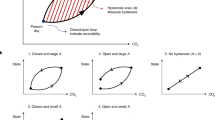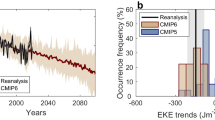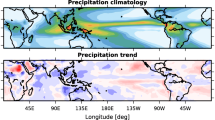Abstract
Records of the past climates show a wide range of values of the equator-to-pole temperature gradient, with an apparent universal relationship between the temperature gradient and the globalmean temperature: relative to a reference climate, if the global-mean temperature is higher (lower), the greatest warming (cooling) occurs at the polar regions. This phenomenon is known as polar amplification. Understanding this equator-to-pole temperature gradient is fundamental to climate and general circulation, yet there is no established theory from a perspective of the general circulation. Here, a general circulation-based theory for polar amplification is presented. Recognizing the fact that most of the available potential energy (APE) in the atmosphere is untapped, this theory invokes that La-Niña-like tropical heating can help tap APE and warm the Arctic by exciting poleward and upward propagating Rossby waves.
Similar content being viewed by others
References
Abbot, D. S., and E. Tziperman, 2008a: A high-latitude convective cloud feedback and equable climates. Quart. J. Roy. Meteor. Soc., 134, 165–185.
—, and —, 2008b: Sea ice, high-latitude convection, and equable climates. Geophys. Res. Lett., 35, L03702, doi:10.1029/2007 GL032286.
—, C.C. Walker, and E. Tziperman, 2009: Can a convective cloud feedback help to eliminate winter and spring sea ice at high CO2 concentrations? J. Climate, 22, 5719–5731.
Alexeev, V. A., P. L. Langen, and J. R. Bates, 2005: Polar amplification of surface warming on an aquaplanet in “ghost forcing” experiments without sea ice feedbacks. Clim. Dynam., 24, 655–666.
Bannon, P. R., 2012: Atmospheric available energy. J. Atmos. Sci., 69, 3745–3762.
Barron, E. J., W. H. Peterson, D. Pollard, and S. L. Thompson, 1993: Past climate and the role of ocean heat transport: model simulations for the Cretaceous. Paleoceanography, 8, 785–798.
Bekryaev, Roman V., Igor V. Polyakov, and Vladimir A. Alexeev, 2010: Role of Polar Amplification in Long-Term Surface Air Temperature Variations and Modern Arctic Warming. J. Climate, 23, 3888–3906.
Bralower, T. J., D. J. Thomas, J. C. Zachos, M. M. Hirschmann, U. Rohl, H. Sigudsson, H. E. Thomas, and D. L. Whitney, 1997: High-resolution records of late Paleocene thermal maximum and circum-Caribbean volcanism: Is there a causal link? Geology, 25, 963–966.
Budyko, M. I., 1969: The effect of solar radiation variations on the climate of the earth. Tellus, 21, 611–619.
—, and Y. A. Izrael, 1991: In Anthropogenic Climate Change, ed. M. I. Budyko, Y. A. Izrael, pp. 277–318. Tucson: Uni. Ariz. Press.
Caballero, R., and M. Huber, 2010: spontaneous transition to superrotation in warm climates simulated by CAM3. Geophys. Res. Lett., 37, doi:10.1029/2010GL043468.
Charney, J. G., and P. G. Drazin, 1961: propgation of planetary-scale disturbances from the lower into the upper atmosphere. J. Geophys. Res., 66, 83–109.
—, and M. E. Stern, 1962: On the instability of internal baroclinic jets in a rotating atmosphere. J. Atmos. Sci. 19, 159–172.
Chiang, John C. H., M. Biasutti, and D. S. Battisti, 2003: Sensitivity of the Atlantic Intertropical Convergence Zone to Last Glacial Maximum boundary conditions. Paleoceanography, 18(4), doi:10.1029/2003PA 000916.
Cehelsky, P., and K. K. Tung, 1987: Theories of multiple equilibria and weather regimes-A critical reexamination. Part II: Baroclinic two-layer models. J. Atmos. Sci., 44, 3282–3303.
Clement, A. C., R. Seager, M. A. Cane, and S. E. Zebiak, 1996: An ocean dynamical thermostat. J. Climate, 9, 2190–2196.
DeConto, R. M., E. C. Brady, J. C. Bergengren, and W. W. Hay, 2000: Late Cretaceous climate, vegetation and ocean interactions in Warm Climates in Earth History, B. R. Huber, K. G. MacLeod, S. L. Wing, Eds., Cambrige Univ. Press, pp. 275–296.
Douglas, R. G., and S. M. Savin, 1978: Oxygen isotopic evidence for the depth stratification of Tertiary and Cretaceous planktic foraminifera. Mar. Micropaleontol., 3, 175–196.
Durack, P. J., and S. E. Wijffels, 2010: Fifty-year trends in global ocean salinities and their relationship to broad-scale warming. J. Climate, 23, 4342–4362.
Farrell, B. F., 1990: Equable climate dynamics. J. Atmos. Sci., 47, 2986–2995.
Flourney, M., S. B. Feldstein, S. Lee, and E. Clothiaux 2014: On the linkage between station downward infrared radiation data, teleconnections, and tropical convection. In preparation.
Garfinkel, C. I., D. L. Hartmann, and F. Sassi, 2010: Tropical precursors of anomalous Northern Hemisphere stratospheric polar vortices. J. Climate, 23, 3282–3299.
—, S. B. Feldstein, D. W. Waugh, C. Yoo, and S. Lee, 2012: Observed connection between stratospheric sudden warmings and the Madden-Julian Oscillation. Geophys. Res. Lett., 39, http://dx.doi.org/10.1029/2012GL053144.
Graversen, R. G., 2006: Do changes in the midlatitude circulation have any impact on the Arctic surface air temperature trend? J. Climate, 19, 5422–5438.
—, and M. Wang, 2009: Polar amplification in a coupled climate model with locked albedo. Clim. Dynam., 33, 629–643, doi:10.1007/s00382-009-0535-6.
Hansen, J., A. Lacis, D. Rind, G. Russell, P. Stone, I. Fung, R. Ruedy, and J. Lerner, 1984: Climate sensitivity: Analysis of feedback mechanisms. Climate Processes and Climate Sensitivity. Geoph. Monog. series, 29, Amer. Geophys. Union, 130–163 pp.
Held, I. M., and V. D. Larichev, 1996: Scaling theory for horizontally homogeneous, baro- clinically unstable flow on a beta-plane. J. Atmos. Sci., 53, 945–952.
—, and B. J. Soden, 2006: Robust response of the hydrological cycle to global warming. J. Climate, 5686–5699.
Hoffert, M. I., and C. Covey, 1992: Deriving global climate sensitivity from palaeoclimate reconstructions. Nature, 360, 573–576.
Honda, M., J. Inoue, and S. Yamane, 2009: Influence of low Arctic sea-ice minima on anomalously cold Eurasian winters. Geophys. Res. Lett., 36, L08707, doi:10.1029/2008GL037079.
Hoskins, B. J., and D. Karoly, 1981: the steady linear response of a spherical atmosphere to thermal and orographic forcing. J. Atmos. Sci., 38, 179–1196.
Huber, B., K. G. MacLeod, and S. L. Wing, 2000: Warm Climates in Earth History. Cambridge Press, 462 pp.
Huber, M. 2008: A hotter greenhouse? Science, 321, 353–354.
Huang, H.-P., K. M. Weickmann, and C. J. Hsu, 2001: Trend in atmospheric angular momentum in a transient climate change simulation with greenhouse gas and aerosol forcing. J. Climate, 14, 1525–1534.
Hwang, Y.-T., and D. M. W. Frierson, 2010: Increasing atmo- spheric poleward energy transport with global warming. Geophys. Res. Lett., 37, L24807, doi:10.1029/2010GL045440.
Johanneseen, O. M., and Coauthors, 2004: Arctic climate change: observed and modeled temperature and sea-ice variability. Tellus, 56A, 328–341.
Kim, H. K., and S. Lee, 2001: Hadley cell dynamics in a primitive equation model. Part II: Nonaxisymmetric flow. J. Atmos. Sci., 58, 2859–2871.
Korty, R. L., K. A. Emanuel, and J. R. Scott, 2008: Tropical cycloneinduced upper-ocean mixing and climate: Application to equable climates. J. Climate, 21, 638–654.
Koutavas, A., J. Lynch-Stieglitz, T. M. Marchitto Jr., and J. P. Sachs, 2002: El Niño-Like Pattern in Ice Age Tropical Pacific Sea Surface Temperature. Science, 297, 226–230, doi: 10.1126/science.1072376.
Kump, L. R., and D. Pollard, 2008: Amplification of Cretaceous warmth by biological cloud feedbacks. Science, 320, 195.
L’Heureux, M. L., S. Lee, and B. Lyon, 2013: Recent multidecadal strengthening of the Walker circulation across the tropical Pacific. Nature Climate Change, 3, 571–576, doi:10.1038/NCLIMATE1840.
Lea, D. W., D. K. Pak, and H. J. Spero, 2000: Climate impact of late quaternary equatorial pacific sea surface temperature variations. Science, 289, 1719. doi: 10.1126/science.289.5485.1719
Lee, S., 1999: Why are the climatological zonal mean winds easterly in the equatorial upper troposphere? J. Atmos. Sci., 56, 1353–1363.
—, S. Feldstein, D. Pollard, and T. White, 2011a: Can planetary wave dynamics explain equable climates? J. Climate, 24, 2391–2404.
—, T. Gong, N. Johnson, S. B. Feldstein, and D. Pollard, 2011b: On the possible link between tropical convection and the Northern Hemisphere Arctic surface air temperature change between 1958 and 2001. J. Climate, 24, 4350–4367.
—, 2012: Testing of the Tropically Excited Arctic Warming Mechanism (TEAM) with traditional El Niño and La Niña. J. Climate, 25, 4015–4022, doi: 10.1175/jcli-d-12-00055.1.
Li, L., A. P. Ingersoll, X. Jiang, D. Feldman, and Y. L. Yung, 2007: Lorenz energy cycle of the global atmosphere based on reanalysis datasets. Geophys. Res. Lett., 34, L16813.
Lindzen, R. S., and B. Farrell, 1980: The role of polar regions in global climate, and the parameterization of global heat transport. Mon. Weather Rev., 108, 2064–79.
Liu, J., J. A. Curry, H. Wang, M. Song, and R. M. Horton, 2012: Impact of declining Arctic sea ice on winter snowfall. PNAS, 109, 4074–4079, doi: 10.1073/pnas.1114910109.
Lorenz, E. N., 1955: Available potential energy and the maintenance of the general circulation. Tellus, 7, 157–167.
Lu, J., and M. Cai, 2010: Quantifying contributions to polar warming amplification in an idealized coupled general circu- lation model. Clim. Dynam., 34, 669–687.
Madden R. A., and P. R. Julian, 1971: Detection of a 40-50 day oscillation in the zonal wind in the tropical Pacific. J. Atmos. Sci., 28, 702–708.
—, and —, 1972: Description of global scale circulation cells in the Tropics with 40-50 day period. J. Atmos. Sci., 29, 1109–1123.
Manabe, S., and R. T. Wetherald, 1975: The effect of doubling the CO2 concentration on the climate of a general circulation model. J. Atmos. Sci., 32, 3–15.
—, and R. J. Stouffer, 1980: Sensitivity of global climate model to an increase of CO2 concentration in the atmosphere. J. Geophys. Res., 85, 5529–5554.
Masson-Delmotte, and Coauthors, 2006: Past and future polar amplification of climate change: climate model intercomparisons and ice-core constraints. Clim. Dynam., 26, 513–529.
Matthews, A. J., B. J. Hoskins, and M. Masutani, 2004: The global response to tropical heating in the Madden-Julian Oscillation during the northern winter. Quart. J. Roy. Meteor. Soc., 130, 1991–2011, doi: 10.1256/qj.02.123.
McKenna, M., 1980: Eocene paleolatitude, climate, and mammals of Ellesmere Island. Palaeogeogr. Palaeocl., 30, 349–362.
Meehl, G. A., and Coauthors, 2007: Global Climate Projections. In: Climate Change 2007: The Physical Science Basis. Contribution of Working Group I to the Fourth Assessment Report of the Intergovernmental Panel on Climate Change [S. Solomon, D. Qin, M. Manning, Z. Chen, M. Marquis, K. B. Averyt, M. Tignor and H. L. Miller (eds.)]. Cambridge University Press, Cambridge, United Kingdom and New York, NY, USA.
Miller, G. H., R. B. Alley, J. Brigham-Grette, J. J. Fitzpatrick, L. Polyak, M. C. Serreze, and J. W. C. White, 2010: Arctic amplication: can the past constrain the future? Quat. Sci. Rev., 29, 1779–1790, doi:10.1016/ j.quascirev.2010.02.008
Otto-Bliesner, B. L., and G. R. Upchurch, 1997: Vegetation-induced warming of high-latitude regions during the late Cretaceous period. Nature, 385, 804–807.
Overland, J. E., and M. Wang, 2010: Large-scale atmospheric circulation changes associated with the recent loss of Arctic sea ice. Tellus, 62A, 1–9.
Park, H.-S., S. Lee, S.-W. Son, Y. Kosaka, and S. B. Feldstein 2014: Rapid increase in Arctic winter downward longwave radiation and sea ice melting. In preparation.
Pearson, P. N., P. W. Ditchfield, J. Singano, K. G. Harcourt-Brown, C. J. Nicholas, R. K. Olsson, N. J. Shackleton, and M. A. Hall, 2001: Warm tropical sea surface temperatures in the Late Cretaceous and Eocene epochs. Nature, 413, 481–487.
Pedlosky, J., 1964: The stability of currents in the atmosphere and ocean. Part I. J. Atmos. Sci., 21, 201–219.
Peixoto, J. P., and A. H. Oort, 1992: Physics of Climate. American Institute of Physics, 520 pp.
Persson, P. O., 2012: Onset and end of the summer melt season over sea ice: thermal structure and surface energy perspective from SHEBA. Clim. Dynam., 39, 1349–1371. doi:10.1007/s00382-011-1196-9
Petoukhov, V., and V. A. Semenov, 2010: A link between reduced Barents-Kara sea ice and cold winter extremes over northern continents. J. Geophys. Res., 115, D21111, doi:10.1029/2009JD013568.
Pfeffer, R. L., 1981: Wave-mean flow interactions in the atmosphere. J. Atmos. Sci., 38, 1340–1359.
Rickaby, R. E. M., and P. Halloran, 2005: Cool La Niña during the warmth of the Pliocene? Science, 307(5717), 1948–1952. doi: 10.1126/science.1104666.
Rigor, I. G., R. L. Colony, and S. Martin, 2000: Variations in surface air temperature observations in the Arctic, 1979-97. J. Climate, 13, 896–914.
Salmon, R., 1980: Baroclinic instability and geostrophic turbulence. Geophys. Astro. Fluid, 15, 167–211.
Saravanan, R., 1993: Equatorial superrotation and maintenance of the general circulation in two-level models. J. Atmos. Sci., 50, 1211–1227.
Sardeshmukh, P. D., and B. J. Hoskins, 1988: The Generation of Global Rotational Flow by Steady Idealized Tropical Divergence. J. Atmos. Sci., 45, 1228–1251.
Serreze, M. C., and R. G. Barry, 2011: Processes and impacts of Arctic amplification: A research synthesis. Quat. Sci. Rev., 77, 85–96, doi: 10.1016/j.gloplacha.2011.03.004
Sewall, J. O., and L. C. Sloan, 2004: Arctic Ocean and reduced obliquity on early Paleogene climate. Geology, 32, 477–480.
Singarayer, J. S., J. L. Bamber, and P. J. Valdes, 2006: Twenty-first-century climate impacts from a declining Arctic sea ice cover. J. Climate, 19, 11091125.
Sloan, L. C., J. C. G. Walker, and T. C. Moore, 1995: The role of oceanic heat transport in early Eocene climate. Paleoceanography, 10, 347–356.
Sohn, B. J., and S.-C. Park, 2010: Strengthened tropical circulations in past three decades inferred from water vapor transport. J. Geophys. Res., 115, D15112.
Spicer, R. A., A. Ahlberg, A. B. Herman, C.-C. Hofmann, M. Raikevich, P. J. Valdes, and P. J. Markwick, 2008: The Late Cretaceous continental interior of Siberia: A challenge for climate models. Earth Plan. Sci. Lett., 267, 228–235.
Sriver, R. L., and M. Huber, 2007: Observational evidence for an ocean heat pump induced by tropical cyclones. Nature, 447, 577–580.
Stevens, B., and S. Bony, 2013: What are climate models missing? Science, 340, 1053; doi: 10.1126/science.1237554.
Stone, P. H., 1978: Baroclinic adjustment. J. Atmos. Sci. 35, 561–71.
Stott, L., C. Poulsen, S. Lund, and R. Thunell, 2002: Super ENSO and global climate oscillations at millennial time scales. Science, 297, 222, doi: 10.1126/science.1071627.
Stroeve, J., M. C. Serreze, M. M. Holland, J. E. Kay, J. Malanik, and A. P. Barrett, 2012: The Arctic’s rapidly shrinking sea ice cover: a research synthesis. Climatic Change, 110, 1005–1027, doi:10.1007/s10584-011-0101-1
Tarduno, J. A., D. B. Brinkman, P. R. Renne, R. D. Cottrell, H. Scher, and P. Castillo, 1998: Evidence for extreme climatic warmth from late Cretaceous Arctic vertebrates. Science, 282, 2241–2244.
Vallis, G. K., 1988: Numerical studies of eddy transport properties in eddyresolving and parameterized models. Quart. J. Roy. Meteor. Soc., 114, 183–204.
Vecchi, G. A., and B. J. Soden, 2007: Global warming and the weakening of the tropical circulation. J. Climate, 20, 4316–4340.
Visser, K., R. Thunell, and L. Stott, 2003: Magnitude and timing of temperature change in the Indo-Pacific warm pool during deglaciation. Nature, 421, 152–155.
Walker, C. C., and T. Schneider, 2006: Eddy influences on Hadley circulations: Simulations with an idealized GCM. J. Atmos. Sci., 63, 3333–3350.
Walsh, J. E., W. L. Chapman, V. E. Romanovsky, J. H. Christensen, and M. Stendel, 2008: Global climate model performance over Alaska and Greenland. J. Climate, 21, 6156–6174.
Wang, X., and J. R. Key, 2005: Arctic surface, cloud, and radiation properties based on the AVHRR polar pathfinder dataset. Part II: recent trends. J. Climate, 18, 2575–2593.
Winton, M., 2006: Amplified Arctic climate change: what does surface albedo feedback have to do with it. Geophys. Res. Lett., 33, doi: 10.1029/2005GL025244.
Wu, Y., M. Ting, R. Seager, H.-P. Huang, and M. Cane, 2010: Changes in storm tracks and energy transports in a warmer climate simulated by the GFDL CM2.1 model. Clim. Dynam., 37, 53–72, doi:10.1007/s00382-010-0776-4.
Yoo, C., S. Feldstein, and S. Lee, 2011: The impact of the Madden-Julian oscillation trend on the Arctic amplification of surface air temperature during the 1979-2008 boreal winter. Geophys. Res. Lett., 38, L24804, doi:10.1029/2011GL049881.
—, S. Lee, and S. B. Feldstein, 2012a: Mechanisms of extratropical surface air temperature change in response to the Madden-Julian oscillation. J. Climate, 25, 5777–5790, doi: 10.1175/jcli- d-11-00566.1.
—, —, and —, 2012b: Arctic response to an MJO-like tropical heating in an idealized GCM. J. Atmos. Sci., 69, 2379–2393, DOI: 10.1175/JAS-D-11-0261.1.
Zelinka, M. D., and D. L. Hartmann, 2012: Climate feedbacks and their implications for poleward energy flux changes in a warming climate. J. Climate, 25, 608–624.
Author information
Authors and Affiliations
Corresponding author
Rights and permissions
About this article
Cite this article
Lee, S. A theory for polar amplification from a general circulation perspective. Asia-Pacific J Atmos Sci 50, 31–43 (2014). https://doi.org/10.1007/s13143-014-0024-7
Received:
Accepted:
Published:
Issue Date:
DOI: https://doi.org/10.1007/s13143-014-0024-7




